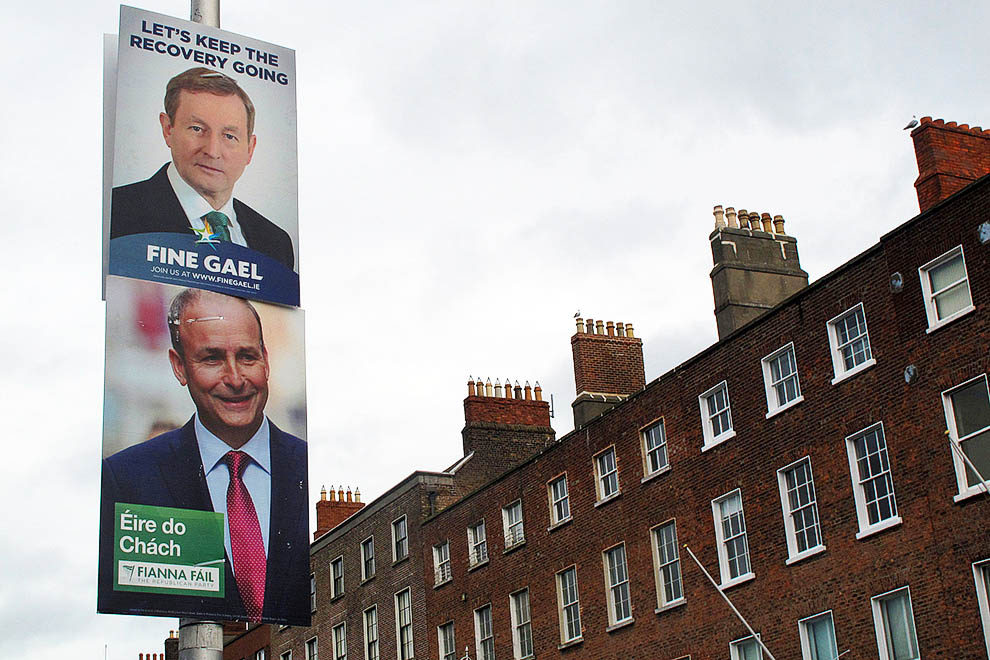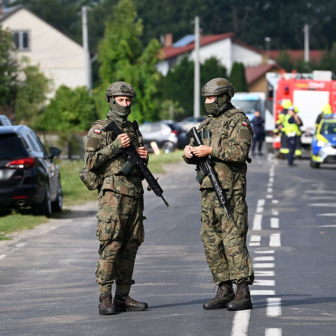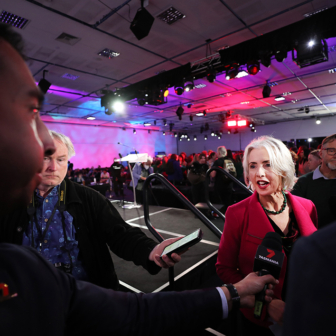To many observers, the 26 February Irish election looked like it should have been a cakewalk for the centre-right Fine Gael party. It had won government five years earlier, in 2011, after the popularity of its more successful rival, Fianna Fáil, collapsed in the wake of the global financial crisis. It was the largest party in the lower house of parliament – the Dáil – and had governed in coalition with the centre-left Labour Party. With a total of 113 seats in a parliament of 166, Fine Gael’s leader, Enda Kenny, had the largest majority in the history of the state.
Kenny became taoiseach, or prime minister, at a time when the state was effectively being run by the “troika” of the International Monetary Fund, the European Central Bank and the European Commission. The new government’s role was to clean up Fianna Fáil’s mess and implement the stringent austerity package already agreed with the troika.
Five years later, Ireland’s fiscal autonomy had been restored, economic growth rates were once again among the highest in Europe, and unemployment had been halved. Kenny, party leader since 2002, had strong hopes of achieving what had eluded all previous Fine Gael leaders – a second term in government. But when the election did take place, it showed that the Irish public was not so willing to thank the government for fixing Ireland Inc.
The new Dáil is slightly smaller, at 158 seats, but even so the collapse of the government parties was described by one former minister as “catastrophic.” Between them, Fine Gael and Labour won just fifty-seven seats, a 50 per cent reduction since 2011. The results were even worse for Labour itself, which retained just seven seats, down from a record thirty-seven seats. Three sides profited: Fianna Fáil, whose numbers increased from nineteen to forty-four; independents, up from fourteen to twenty-three; and Sinn Féin, which had similar gains. With both Fianna Fáil and Fine Gael refusing to countenance a coalition with Sinn Féin or with each other, no obvious governing arrangement exists.
For some observers, the vote marks the demise of a political divide that dates back to Ireland’s 1922–23 civil war. The February election was the first time since their foundations in the 1920s and 1930s that the combined first-preference vote for Fianna Fáil and Fine Gael was less than 50 per cent. For others, the vote marks the demise of the traditional two-and-a-half-party system, with Fianna Fáil, Fine Gael and Labour winning just 57 per cent of the vote between them, down from an average of 90 per cent in the 1980s. A record number of independents were elected, and between them they won a record 16 per cent of the vote. Something is broken in the party system, and a significant group of voters was searching for an alternative.
But a different analysis of the data suggests that more caution is needed. First, Fine Gael has always won around fifty seats and 26 to 30 per cent of the vote, and at this election it moved back closer to its mean. Likewise, Labour always wins around 8 to 10 per cent of the vote, which is also around where it finished this time. It may also be misleading to compare the fate of those two parties to their highly unusual electoral performances in 2011, when they effectively faced no opposition from Fianna Fáil. And if the party system is really changing as much as some have claimed, we might have seen the newer political parties making more of a mark.
Although a majority of the electorate has expressed a desire for new parties since the onset of the economic recession in 2008, only a small minority chose to vote for those that did emerge. Renua, a socially conservative party formed from former Fine Gael TDs (teachtaí dála: members of parliament) who left the party after abortion law reforms in 2013, failed to win any seats. The Social Democrats, established by three independent TDs, had no new members elected in 2016. The radical left-wing alliance of People Before Profit and the Anti-Austerity Alliance won six seats, while the Greens made a minor comeback, winning two seats after being wiped out in 2011. These parties have eleven seats between them, less than half the total number of independents elected.
The one alternative party that did slightly better was Sinn Féin, although perhaps not as well as some predicted on the basis of opinion polls that put it on a par with Fianna Fáil for much of the past five years. The party’s paramilitary links continued to haunt it, and this, along with the weak performance in national debates of longtime leader Gerry Adams, proved a hindrance to more substantial growth.
While Fianna Fáil may claim that it was the real winner of the election given it gained more seats (twenty-five) than ever before, it came from a very low post-2011 base. This was still Fianna Fáil’s second-worst Dáil election ever, and only the second time it has come in behind Fine Gael.
Still, it is worth remembering that support for Fianna Fáil continued to fall after the seeming nadir of 2011, to an all-time low of 10 per cent in the polls less than five years ago. The party had no representation in the capital, Dublin, no female TDs, and a demoralised parliamentary party. Its leader, Micheál Martin, used the party’s main asset, its voluntary structures and associations, to rebuild Fianna Fáil, and he took much of the credit for restoring its fortunes. From a position where it seemed Sinn Féin might relegate it into third place, Fianna Fáil won almost twice as many seats as its republican rivals, and even came close to overtaking Fine Gael.
Perhaps the real winners in 2016 were the independents. No other national parliament in the democratic world has as many independents as the Irish Dáil. Indeed, it now has more independents than the combined total for all other national parliaments. While independents have always been a feature of the Dáil, their numbers have never been this high. In previous years, they might have been said to be the product of a candidate-centred voting system (the single transferable vote, or Hare-Clark as it is known in Australia) or of parish-pump politics, but the election of so many in 2016 points to some deeper malaise in the Irish political system.
In other European countries, protesting voters opt for populist parties such as the Five Star Movement in Italy, the National Front in France or Podemos in Spain. Ireland is one of the few European countries where extreme-right parties have never been elected to parliament. Instead, populism manifests itself through the prism of independents. For a conservative electorate that tends to shy away from ideological politics, they are an ideal means of protesting. They also indicate deep levels of localism in a country in which, despite the economic uncertainty, “choosing a candidate to look after the local constituency” remained the number one priority for voters.
Women were also winners at the election. Female representation in the Irish parliament has traditionally been low, ranking eighty-sixth in the world before the 2016 election, or proportionally equal to North Korea. As part of a number of political reform initiatives, the outgoing government introduced gender quotas whereby neither gender could make up less than 30 per cent of a party’s ticket of candidates. Failure to reach this quota would result in a loss of half of the state funding received by parties, a substantial amount. The legislation had the desired effect: thirty-five women were elected, a record number for the Irish parliament (the pre-election figure was twenty-five), and a significant achievement given the substantial losses suffered by Labour, usually the main party of female representation.
Unlike his or her Australian and British counterparts, the Irish prime minister must be elected by a formal parliamentary vote of investiture. To be re-elected taoiseach, Enda Kenny needs to attract the support of an additional thirty TDs. With Sinn Féin out of the equation, he has been talking to two groups of independents, the Independent Alliance (with six TDs) and a rural-based group formed since the election. Fianna Fáil’s leader, Micheál Martin, has been doing likewise, although it remains to be seen to what end, since neither Kenny nor Martin is likely to attract majority support. If this proves to be the case, Kenny will have to resign as taoiseach, but will remain head of a caretaker government.
The powers of a caretaker taoiseach are not constitutionally prescribed, but he will remain in the position until the Dáil can elect a replacement. This isn’t the first time this has happened: in both 1989 and 1992 weeks elapsed before a new government was formed. The governments that ultimately did emerge – unprecedented coalitions between Fianna Fáil and the Progressive Democrats (1989), and between Fianna Fáil and the Labour Party (1992) – threatened to shake up the party system, but didn’t bring about fundamental change.
This time, another shock scenario – a grand alliance of Fianna Fáil and Fine Gael – seems almost certain to emerge from what many see as a phoney war between the various sides. For the past two years such a coalition has been a strong favourite with bookmakers. Even though both parties ruled it out during the campaign, the results indicate that, given the ostracism of Sinn Féin, it is the only logical outcome.
Were this alliance to form, it could be the most significant development in the Irish party system since the 1920s. In the centenary of the 1916 rebellion, it could mark an end to civil war politics. But the consequences are more than historic. With the two centre-right parties in government together, a left–right political division might well open up, with the perennially weak left mobilised in opposition.
The left regards its poor record in Irish politics as a reflection of the unnatural division between the civil war parties, which prevented “natural” left–right politics from emerging. Fianna Fáil, in particular, is conscious that being in government with Fine Gael might give Sinn Féin, a party of the left, the opportunity to grow in opposition, where it will be the main party.
Sinn Féin says the difference between Fianna Fáil and Fine Gael is less than the thickness of a cigarette paper, and would privately welcome a coalition between the two main parties. From a strategic point of view, opposition to the government would need to mobilise around Sinn Féin. It has pledged to enter government only as the main party, not as a minor partner. For now, opposition is part of its long game.
It remains to be seen what kind of government will form this year. Fianna Fáil might support a minority Fine Gael government from the outside, as the latter did for a minority Fianna Fáil in 1987 (for which it received little thanks). If Fianna Fáil were to enter government, the option of an unprecedented alternating taoiseach is likely to be on the agenda, given the narrow gap in seats between the two parties.
How long would such a government last? Will old enmities quickly rear their heads at the cabinet table, or will politics be pragmatic, as it usually is in Ireland? Fianna Fáil leader Micheál Martin has promised much-needed parliamentary reform before a new government is formed, in order to enhance the accountability of the government and increase the role of the Dáil. If such reforms are to materialise, Sinn Féin and the independents may well have a more active role in opposition.
The election showed that some change has taken place, and more may be on the way. The people have had their say. Do their representatives share the desire for a renewal of Irish politics? •




